Sharks are the master hunters of the deep, known for their impressive speed and even more impressive bites. Florida is a peninsula surrounded on most sides by water, so it makes sense that there would be a wide variety of sharks on the coastline.
Not all sharks have large teeth ripe for tearing and consuming other animals; a few subsist off small fish and different marine life. Volusia County, Florida, is the shark bite capital of the world, and many swimmers at the beach never even realize they are swimming among the sharks.
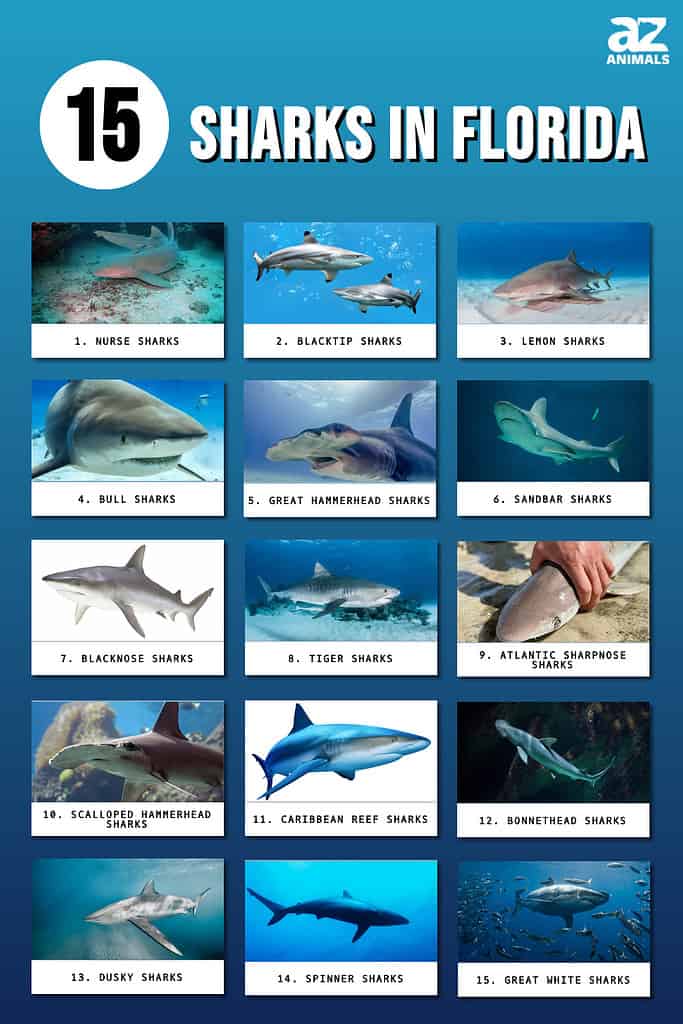
The Most Common Sharks in Florida
Of course, sharks live in the salty brine of the sea, it is their territory, and we are only intruding upon it. A study of 3,000 different sharks found on the coast of Florida showed that there are 15 separate species of sharks in Florida.
The number and type of sharks found are as follows:
- 1,335 Nurse Sharks
- 650 Blacktip Sharks
- 314 Lemon Sharks
- 253 Bull Sharks
- 238 Great Hammerhead
- 210 Sandbar Sharks
- 178 Blacknose Sharks
- 100 Tiger
- 67 Atlantic Sharpnose Sharks
- 22 Scalloped Hammerhead Sharks
- 13 Caribbean Reef Sharks
- 11 Bonnethead Sharks
- 5 Dusky Sharks
- 1 Spinner Shark
- 1 Great White.
Now that your curiosity has been piqued, it’s time to learn a little about each of these sharks.
1. Nurse Sharks

The most common shark to be found in Florida, this one is hardly a fearsome predator. Nurse sharks are known to have cute tiny little teeth, are primarily brown, and subsist off of smaller marine life such as stingrays or mollusks.
They are also one of the only sharks that frequently return to the same place to mate. This is known as mating site fidelity.
Nurse sharks need not be feared as they are not a threat to humans, and they usually stay along the bottom of the ocean searching for their prey. These sharks can grow up to fourteen feet, though, so now and again, a shark bite may happen by accident.
2. Blacktip Sharks

The blacktip shark can thrive in fresh water or saltwater.
©Gino Santa Maria/Shutterstock.com
Blacktip sharks have, believe it or not, black tips to the ends of their fins, including the top dorsal fin that slices through the water to announce their arrival. They live in saltwater, of course, but can also live in brackish waters.
Brackish waters are a mix of fresh water and saltwater. This happens where rivers meet the ocean or in places like mangrove swamps. These sharks do have a bit of a bite and eat primarily fish.
They come in brown and gray with white bottoms to help with their hunting. Blacktip sharks are known to jump out of the water in spin around, making their presence known. They’re also known to be one of the more aggressive shark species, but their bites are still relatively rare.
3. Lemon Sharks
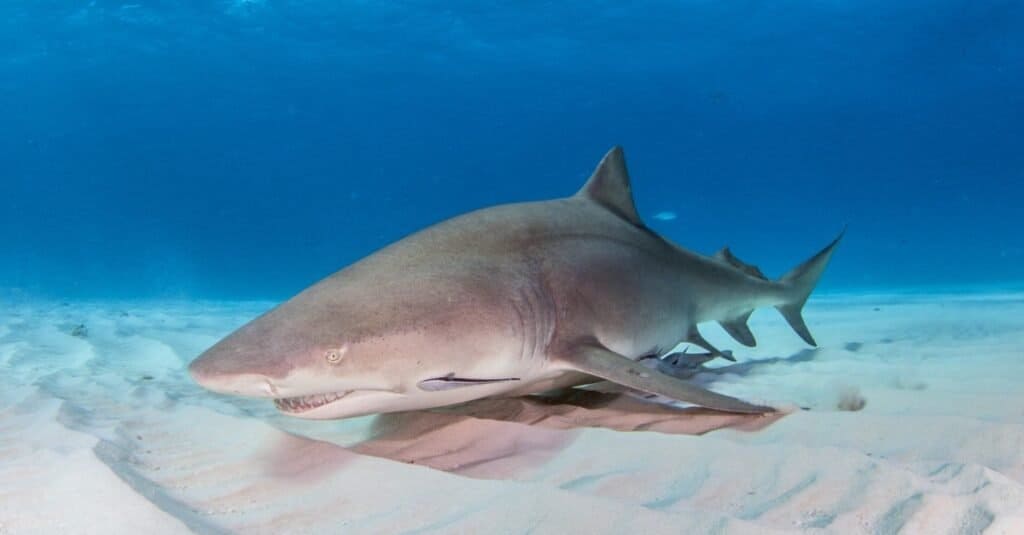
Lemon sharks’ yellow-brown skin helps them camouflage in the sandy waters they inhabit.
©Michael Bogner/Shutterstock.com
Lemon sharks are named for their yellow and brown coloring. The color helps them blend in with the sandy bottoms of the ocean so they can hunt their prey. They live throughout the Atlantic Ocean.
This shark is also very social, and they tend to live within groups of other lemon sharks. Often lemon sharks are hunted for their meat, fins, and skin, and their skin can be used to make leather goods and are considered vulnerable but not endangered.
Lemon sharks are not known to go after humans and bites are extremely rare. They just live their lives mainly hunting for fish and mollusks at night.
4. Bull Sharks
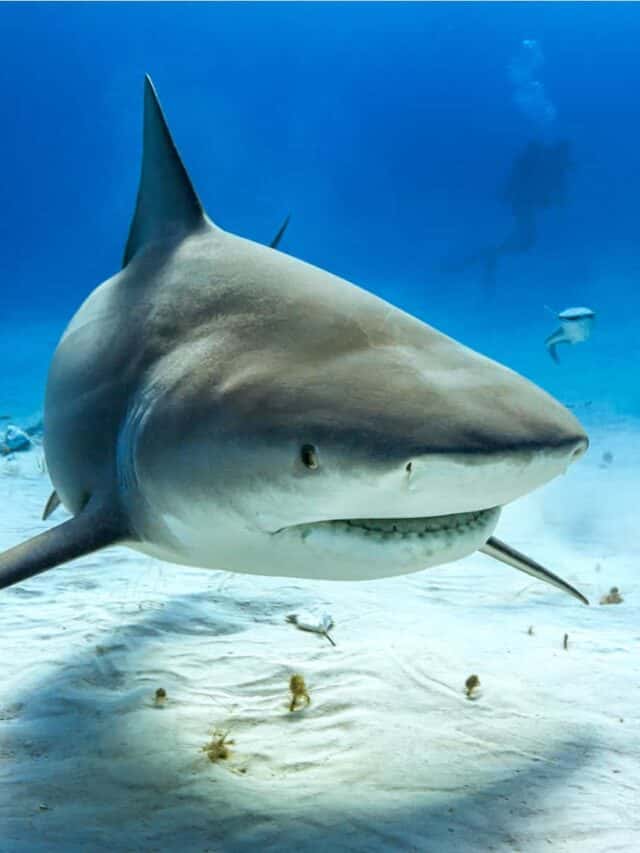
Bull sharks are aggressive!
©Carlos Grillo/Shutterstock.com
Bull sharks have been found swimming up the Mississippi River and can survive in fresh water and saltwater. They are aggressive sharks who swim in low coastal waters and have been known to attack humans.
The large, broad nose of the bull shark gives it its name, along with its aggressive behavior. They use their large heads to head-butt their prey and stun them first. Bull sharks eat a diet that consists of seals, dolphins, otters, a variety of fish, crustaceans, tuna, and shrimp.
5. Great Hammerhead Sharks
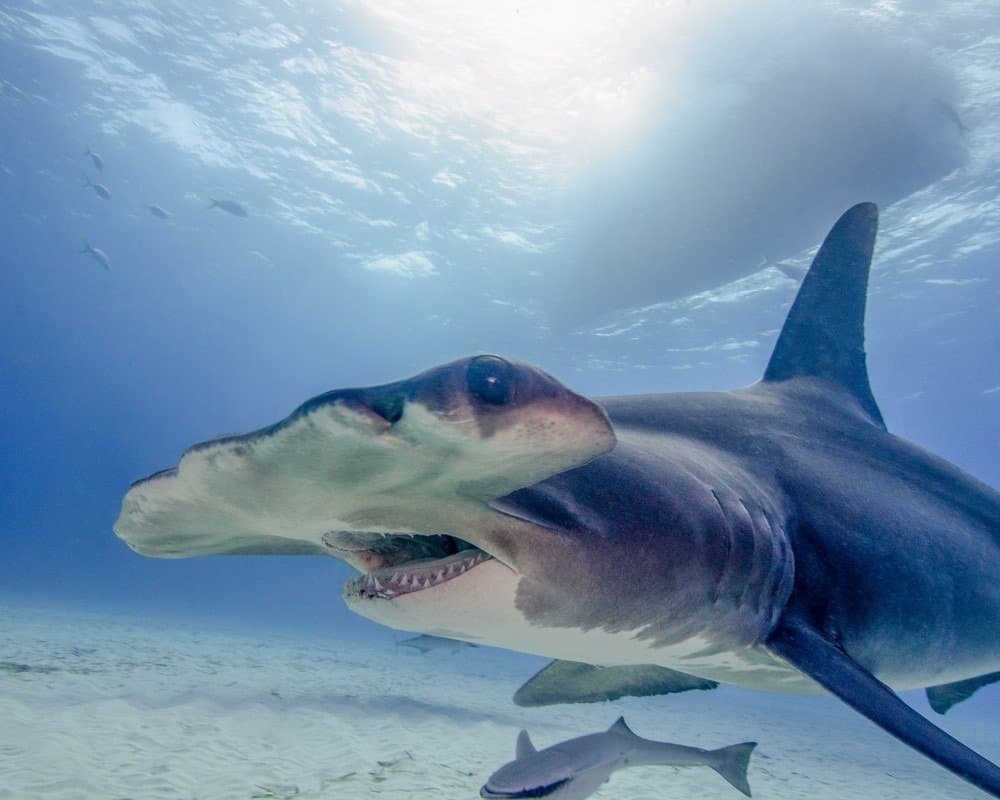
Great hammerhead sharks have been known to eat other sharks.
©Brent Barnes/Shutterstock.com
The great hammerhead shark is different from other hammerheads because its head is not rounded, it is more spread out with a notched center. They swim along with other hammerhead sharks in schools.
What makes great hammerhead sharks unique is that they birth many sharks at a time and can have up to 5,000 pups every two years. They’re also the largest species of hammerhead sharks and the longest recorded individuals can reach lengths that approach close to 20 feet in length.
Behaviorwise, they have been known to be curious about divers and poke around, but they do not often attack humans. They eat all sorts of marine life, including lobsters, fish, and some sharks.
6. Sandbar Sharks
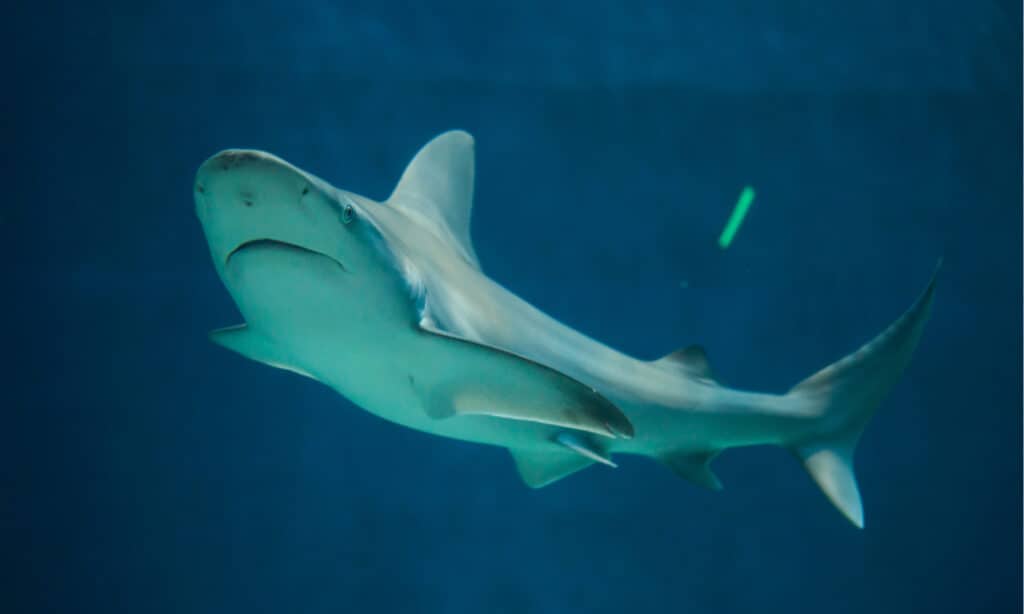
Sandbar sharks often live in estuaries.
©Vladimir Wrangel/Shutterstock.com
Believe it or not, sandbar sharks are often found on sandbars. They hunt the usual prey of fish and other animals in lower water areas. Sandbar sharks can live in freshwater and saltwater and like making their home in estuaries.
An estuary is where the mouth of a river meets other rivers or the sea and combines the water. Their coloring ranges from blue-gray to brown-gray, and they can grow up to six feet or so. Despite being so large, sandbar sharks aren’t known to attack people and are a common shark to swim with.
7. Blacknose Sharks
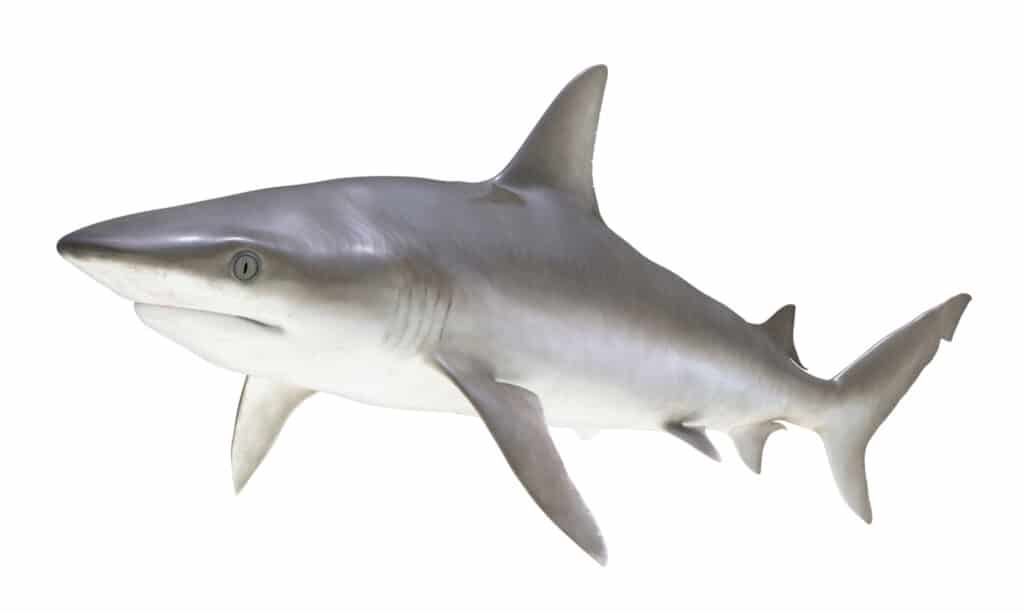
Blacknose sharks have black blotches on their snouts.
©3DMI/Shutterstock.com
These sharks are considered on the small end of sharks at about 4 to 5 feet in length. Blacknose sharks sometimes have a “black blotch” on their noses, hence their name, and are usually grey with white undersides.
People don’t need to fear blacknose sharks because they are not interested in humans as they eat smaller fish and octopuses. They sometimes are even prey to other, larger sharks. People enjoy fishing for blacknose sharks as they are considered a game fish and a challenge to catch.
8. Tiger Sharks
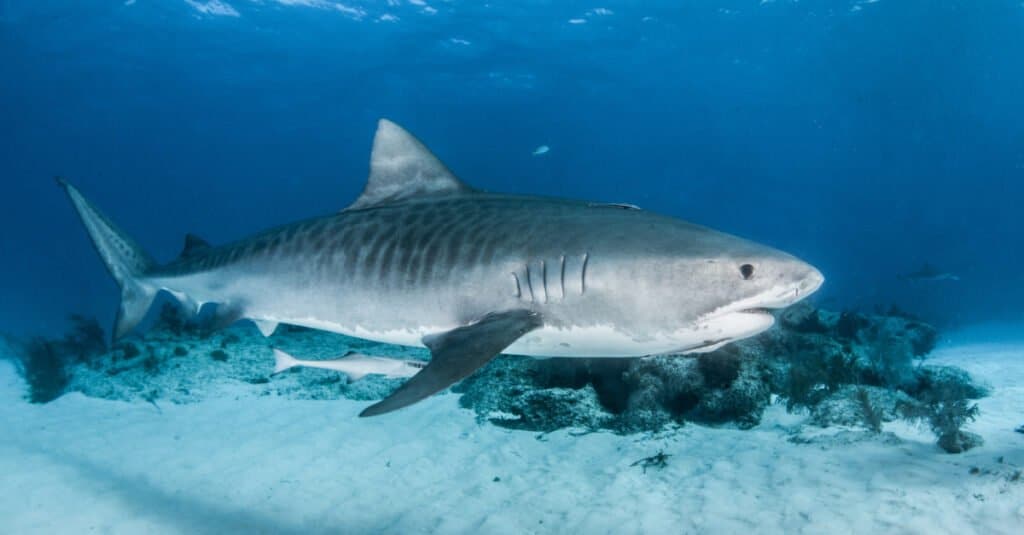
The tiger shark gets its name from the vertical lines that run along the side of its body.
©iStock.com/Divepic
A danger to humans, these sharks have a potentially fatal bite. Tiger sharks rank second behind only great whites in terms of unprovoked shark attacks. There have been 36 recorded fatal attacks from the species.
Tiger sharks are called such because it has dark tiger-like stripes along their gray bodies and a fearsome grin. They are slow swimmers who blend in with the waters easily. This can make them hard to see. While tiger sharks are one of the sharks most responsible for fatal shark attacks on humans, that doesn’t mean they have a taste for human blood.
Dolphins, squid, turtles, snakes, fish, and more are not safe from this predator, tiger sharks will eat them all. Tiger sharks can be consumed by orcas occasionally, so it’s not without its worries.
9. Atlantic Sharpnose Sharks
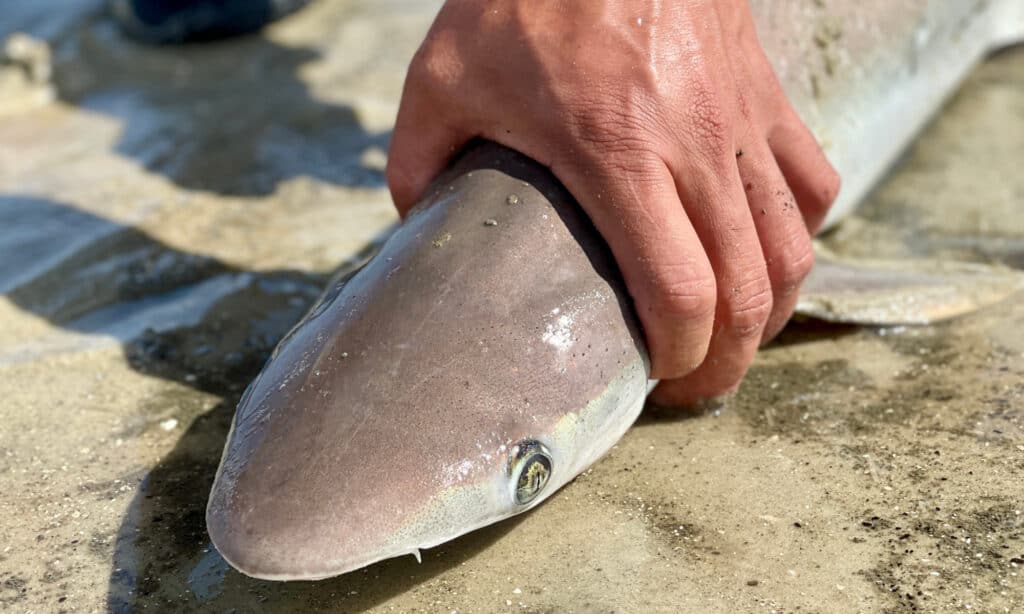
The Atlantic sharpnose is one of the smallest types of shark that grows up to three feet in length.
©Finley Del/Shutterstock.com
Atlantic sharpnoses only grow up to three feet in length, but that doesn’t mean they can’t bite humans. They often swim in low coastal waters and may take a little nibble, though it won’t do too much harm the way a tiger shark’s bite might.
These sharks eat fish, worms, and mollusks, so if you’re fishing, there’s the potential to catch one of these little boys.
10. Scalloped Hammerhead Sharks

The scalloped hammerhead shark is critically endangered.
©Ian Scott/Shutterstock.com
The scalloped shape of this hammerhead shark is more rounded and shovel-like, meaning it can scoop into the seabed and grab its prey. They will eat whatever they can sink their teeth into and aren’t picky. A few parts of their diet include mackerel, squid, and other smaller sharks.
Scalloped hammerhead sharks are considered critically endangered due to overfishing, causing a depletion in their numbers. Their populations have dropped 95% in just 30 years, thanks to both overfishing and the fact that shark fin soup is so popular. Shark finning is one way many types of sharks have become endangered.
11. Caribbean Reef Sharks
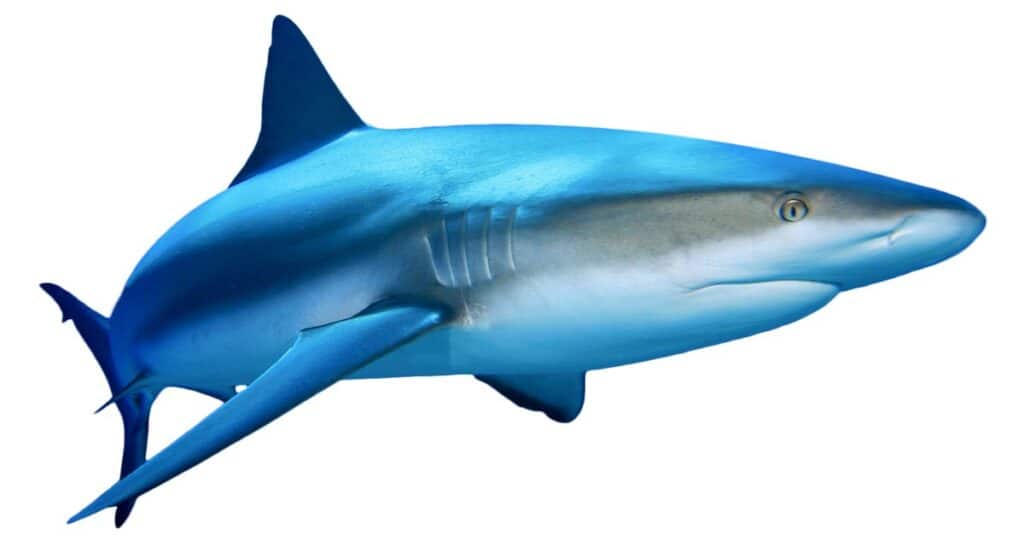
Caribbean reef sharks can grow up to nine feet.
©Rich Carey/Shutterstock.com
If you’re looking for a shark that wants zero to do with humans, you’ve found it. The Caribbean reef shark is known to stay away from humans and is a pretty tolerant predator.
This shark grows between six to nine feet and is pretty average in appearance, with gray skin and a white underside. It is endangered because of the destruction of coral reefs, which are their usual feeding grounds. They can be aggressive and dangerous when feeding, so it’s best to stay away from them just in case.
12. Bonnethead Sharks
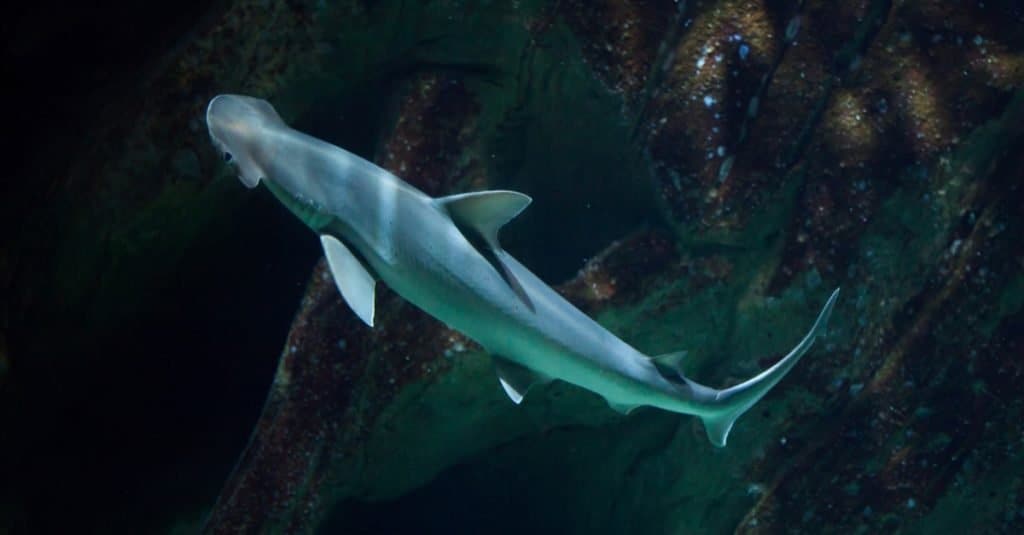
Bonnethead sharks are shy and unlikely to bite humans.
©Vladimir Wrangel/Shutterstock.com
The bonnethead shark is known for being shy and not likely to bite. They have a head that could be described as appearing to wear a bonnet, hence their name, and are just another smaller type of hammerhead shark.
They mainly eat crustaceans like crabs, though they branch out to fish on occasion. Bonnethead sharks also eat seagrass, making them the only known shark to munch on both meat and grasses as an omnivore.
13. Dusky Sharks
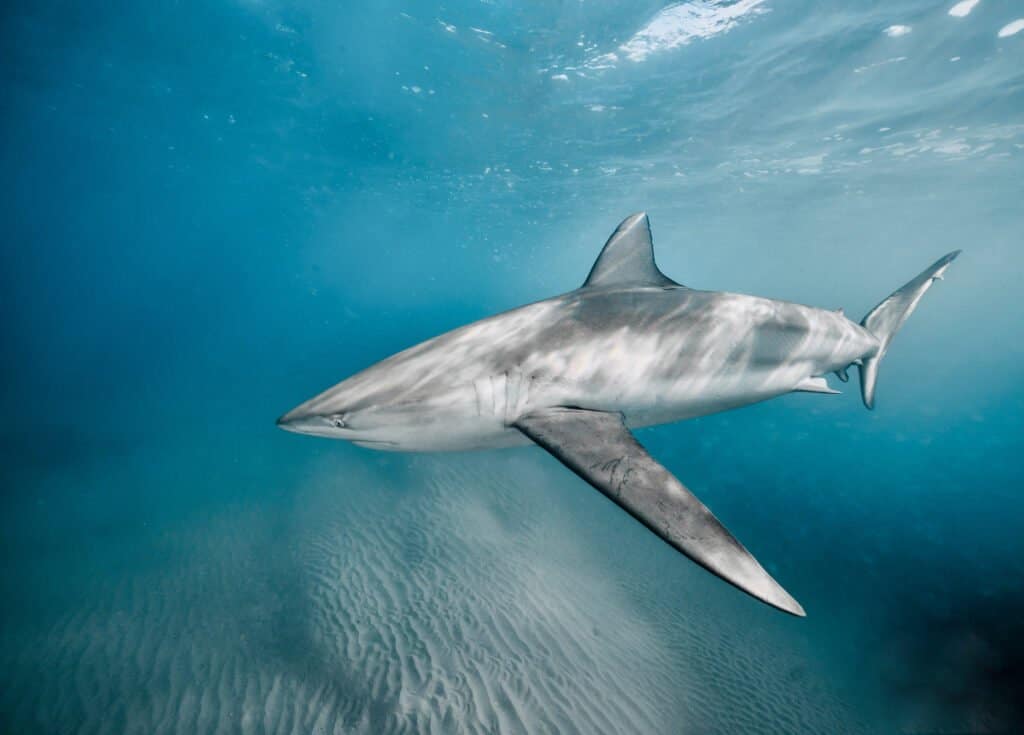
Dusky sharks have the strongest bite of any shark.
©sirtravelalot/Shutterstock.com
Dusky sharks should never be provoked with what is considered the strongest shark bite because they will attack. Otherwise, they show little interest in bothering humans if you leave them alone.
They have the classic shark shape with a shovelnose and are dark gray in color. Dusky sharks eat cephalopods, fish, sea turtles, and have been known to consume literal garbage.
The dusky shark is considered an endangered animal due to human interference with food predation and overrunning their habitats with overfishing.
14. Spinner Shark
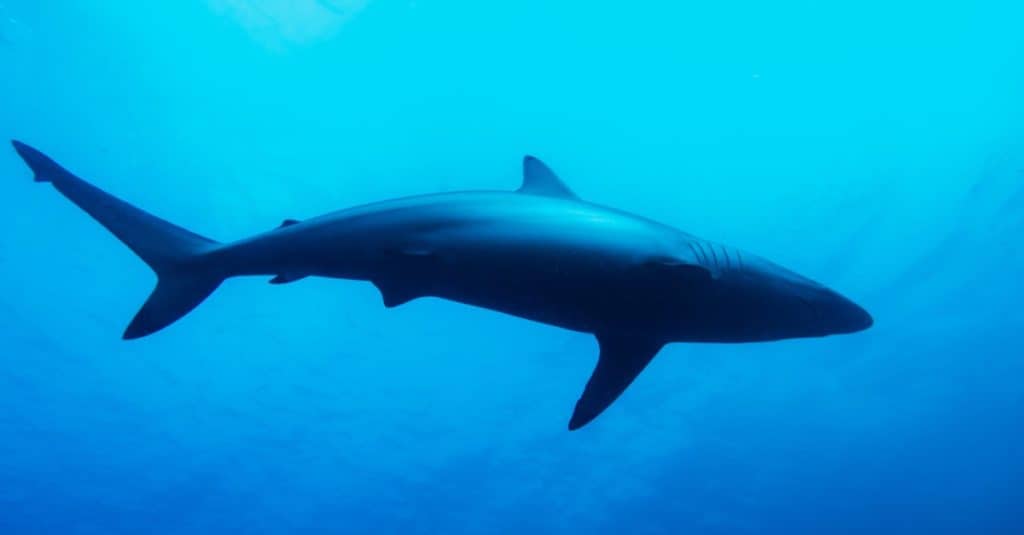
Spinner sharks jump and spin while hunting their prey.
©Chokyky/Shutterstock.com
The spinner shark is known to leap out of the water and spin in the air, hence its name. They are gray-tinted and sometimes brown, with white bands along their outer body.
Spinner sharks jump and spin while hunting, spiraling through schools of fish to consume them and jumping and spinning at the end. They are considered a fun challenge for fishers, and people often eat them as well.
They are not considered super dangerous to humans if not bothered, though they grow up to ten feet in length.
15. Great White Shark
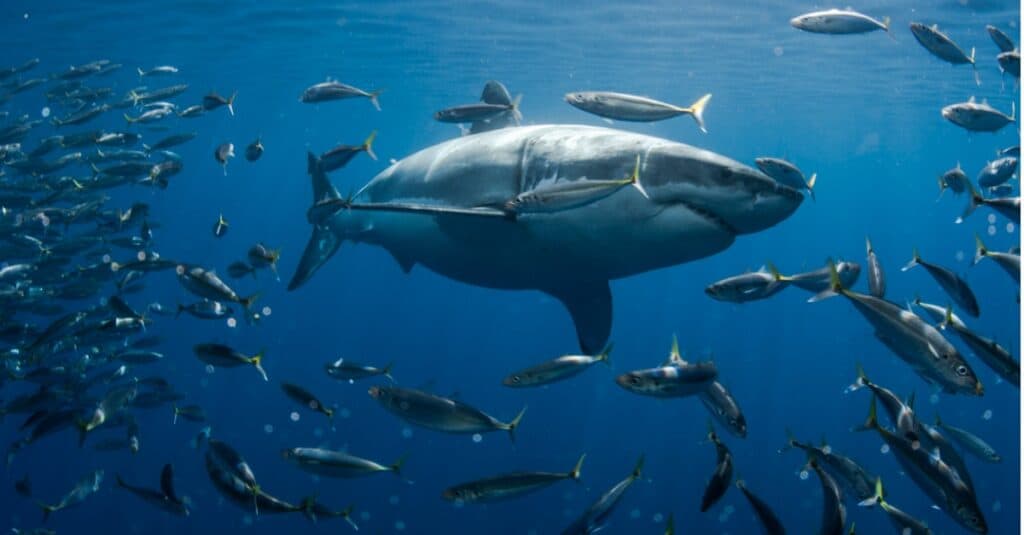
The great white shark attacks humans on accident because of its poor eyesight.
©iStock.com/atese
Last but certainly not least, there was one great white shark found off the coast of Florida during this study. The great white shark is known to attack humans, but not because it has a taste for us. This shark bites humans because it has terrible eyesight and has to take a nibble to see if we are a seal or not.
Their diet consists of seals, sea lions, fish, birds, sea turtles, dolphins, otters, and the occasional garbage they can’t digest. These streamlined sharks are named after their white underbellies and are grey on top. Great white sharks are considered vulnerable throughout the world.
Summary of 15 Sharks in Florida
Here’s a recap of the 15 shark species that are present in Florida that we took a look at.
| Number | Shark Species | Appearance | Threat to Humans |
|---|---|---|---|
| 1 | Nurse Sharks | Primarily brown; can grow up to 14 ft | Not a threat to humans |
| 2 | Blacktip Sharks | Brown and gray with white bottoms, black tips at the ends of fins | One of the more aggressive shark species but bites are still relatively rare |
| 3 | Lemon Sharks | Yellow and brown coloring | Not known to go after humans and bites are extremely rare |
| 4 | Bull Sharks | Large, broad noses; use their large heads to head-butt their prey | Known to attack humans |
| 5 | Great Hammerhead Sharks | Heads are spread out with notched centers; can grow up to 20 ft | Do not often attack humans |
| 6 | Sandbar Sharks | Coloring ranges from blue-gray to brown-gray; grow up to 6 ft | Aren’t known to attack people; a common shark to swim with |
| 7 | Blacknose Sharks | Black blotch on their noses; usually grey with white undersides | Not interested in humans |
| 8 | Tiger Sharks | Have dark tiger-like stripes along their gray bodies | A danger to humans; sharks have a potentially fatal bite; 36 recorded fatal attacks |
| 9 | Atlantic Sharpnose Sharks | Only grow up to 3 ft | May take a little nibble, but won’t do too much harm the way a tiger shark’s bite might |
| 10 | Scalloped Hammerhead Sharks | Scalloped shape, more rounded and shovel-like | Humans are a threat; these sharks are critically endangered due to overfishing and use in shark fin soup |
| 11 | Caribbean Reef Sharks | Gray skin and a white underside; grow 6-9 ft | Known to stay away from humans |
| 12 | Bonnethead Sharks | Head could be described as appearing to wear a bonnet | Shy and not likely to bite |
| 13 | Dusky Sharks | Classic shark shape with a shovelnose and are dark gray in color | Strongest shark bite; can attack but show little interest in humans if left alone |
| 14 | Spinner Sharks | Gray-tinted and sometimes brown, with white bands along the outer body | Not considered super dangerous to humans if not bothered |
| 15 | Great White Sharks | Streamlined shape; grey with white underbelly | Known to attack humans due to terrible eyesight and mistaking people for prey |
The photo featured at the top of this post is © Yann hubert/Shutterstock.com
Thank you for reading! Have some feedback for us? Contact the AZ Animals editorial team.







